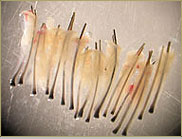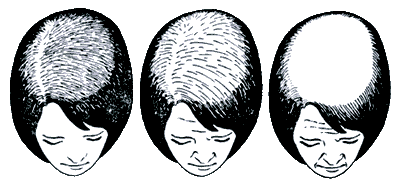Ultra Refined Follicular Unit Hair Transplantation For Men and Women
 Follicular units are distinct groupings of usually one to four terminal hairs.The follicular unit is thus a naturally occuring physiologic, as well as an anatomic entity. Follicular unit transplantation offers the surgeon the ability to transplant the maximum amount of hair with the minimum amount of non-hair bearing skin. In this way, recipient wounds are kept small, healing is facilitated, and with proper technique, large numbers of grafts may be safely moved per session. The use of these units helps to ensure that the cosmetic result of the transplant will appear completely natural. Follicular units are distinct groupings of usually one to four terminal hairs.The follicular unit is thus a naturally occuring physiologic, as well as an anatomic entity. Follicular unit transplantation offers the surgeon the ability to transplant the maximum amount of hair with the minimum amount of non-hair bearing skin. In this way, recipient wounds are kept small, healing is facilitated, and with proper technique, large numbers of grafts may be safely moved per session. The use of these units helps to ensure that the cosmetic result of the transplant will appear completely natural.
In contrast to follicular units, micrografts (1-2 hairs), and mini-grafts (3-6 hairs), are small grafts cut randomly from donor hair, not specifically as individual intact follicular units. These multiple units will contain extra skin that will demand larger recipient sites, which, in turn, causes more wounding to the recipient bed and may limit the number of grafts that can safely be transplanted in a session.
Although, it is hard to argue the superiority of the follicular unit technique in theory, in practice, follicular unit transplantation is tedious, demanding on the physician and staff, and requires a relatively high degree of expertise to be properly performed.
The evolution of microscopic dissection and follicular unit transplantation has been that this procedure can be practical for other parts of the body including eyebrows and eyelashes. It has also become much more viable as an alternative for female pattern hair loss which is usually more diffuse.
Female Hair Loss
Female hair loss occurs in more than one pattern. If you are a woman with loss of scalp hair, you should seek professional advice from a physician hair restoration specialist.
In most cases, female hair loss can be effectively treated. If you are a woman who has started to lose scalp hair, you are not alone if:
You are unpleasantly surprised by the hair loss, and You don’t understand why you are losing hair. The patterns of hair loss in women are not as easily recognizable as those in men.
Hair loss in men is likely to occur primarily between late teen-age years and age 40-50, in a generally recognizable "male-pattern" baldness known as androgenetic alopecia. Men with male-pattern hair loss may have an expectation of hair loss if they have male relatives who lost hair in a recognizably male pattern (Click here to learn more about male-pattern hair loss).
 |
|
Grade 1
|
Grade 2
|
Grade 3
|
Unlike hair loss in men, female scalp hair loss may commonly begin at any age through 50 or later, may not have any obvious hereditary association, and may not occur in a recognizable "female-pattern alopecia" of diffuse thinning over the top of the scalp. A woman who notices the beginning of hair loss may not be sure if the loss is going to be temporary or permanent—for example, if there has been a recent event such as pregnancy or illness that may be associated with temporary hair thinning.
If you are a woman who is worried about loss of scalp hair, you should consult a physician hair restoration specialist for an evaluation and diagnosis.
Self-diagnosis is often ineffective. Women tend to have less obvious patterns of hair loss than men, and non-pattern types of hair loss are more frequent in women than in men. Diagnosis of hair loss in a woman should be made by a trained and experienced physician.
In women as in men, the most likely cause of scalp hair loss is androgenetic alopecia—an inherited sensitivity to the effects of androgens (male hormones) on scalp hair follicles. However, women with hair loss due to this cause usually do not develop true baldness in the patterns that occur in men—for example, women rarely develop the "cue-ball" appearance often seen in male-pattern androgenetic alopecia.
Patterns of female androgenetic alopecia can vary considerably in appearance. Patterns that may occur include:
- Diffuse thinning of hair over the entire scalp, often with more noticeable thinning toward the back of the scalp.
- Diffuse thinning over the entire scalp, with more noticeable thinning toward the front of the scalp but not involving the frontal hairline.
- Diffuse thinning over the entire scalp, with more noticeable thinning toward the front of the scalp, involving and sometimes breaching the frontal hairline.
Unlike the case for men, thinning scalp hair in women due to androgenetic alopecia does not uniformly grow smaller in diameter (miniaturize). Women with hair loss due to androgenetic alopecia tend to have miniaturizing hairs of variable diameter over all affected areas of the scalp. While miniaturizing hairs are a feature of androgenetic alopecia, miniaturization may also be associated with other causes and is not in itself a diagnostic feature of androgenetic alopecia. In post-menopausal women, for example, hair may begin to miniaturize and become difficult to style. The precise diagnosis should be made by a physician hair restoration specialist.
It is important to note that female pattern hair loss can begin as early as the late teens to early 20s in women who have experienced early puberty. If left untreated, this hair loss associated with early puberty can progress to more advanced hair loss if it is left untreated.
Non-Pattern Causes of Hair loss in Women
In women more often than in men, hair loss may be due to conditions other than androgenetic alopecia. Some of the most common of these causes are:
Trichotillomania—compulsive hair pulling. Hair loss due to trichotillomania is typically patchy, as compulsive hair pullers tend to concentrate the pulling in selected areas. Hair loss due to this cause cannot be treated effectively until the psychological or emotional reasons for trichotillomania are effectively addressed.
Alopecia areata—a possibly autoimmune disorder that causes patchy hair loss that can range from diffuse thinning to extensive areas of baldness with "islands" of retained hair. Medical examination is necessary to establish a diagnosis.
Triangular alopecia—loss of hair in the temporal areas that sometimes begins in childhood. Hair loss may be complete, or a few fine, thin-diameter hairs may remain. The cause of triangular alopecia is not known, but the condition can be treated medically or surgically.
Scarring alopecia—hair loss due to scarring of the scalp area. Scarring alopecia typically involves the top of the scalp and occurs predominantly in women. The condition frequently occurs in African-American women and is believed to be associated with persistent tight braiding or "corn-rowing" of scalp hair. A form of scarring alopecia also may occur in post-menopausal women, associated with inflammation of hair follicles and subsequent scarring.
Telogen effluvium—a common type of hair loss caused when a large percentage of scalp hairs are shifted into "shedding" phase. The causes of telogen effluvium may be hormonal, nutritional, drug-associated, or stress-associated.
Loose-anagen syndrome—a condition occurring primarily in fair-haired persons in which scalp hair sits loosely in hair follicles and is easily extracted by combing or pulling. The condition may appear in childhood, and may improve as the person ages.
Diagnosis and Treatment
If you are a woman with thinning or lost scalp hair, your first necessary step is to have the condition correctly diagnosed by a physician hair restoration specialist. After a diagnosis is made, the physician will recommend an approach to effective medical or surgical treatment (Click on Surgical Treatment and Non-Surgical Treatment).
References
Olsen EA (ed). Female Pattern Hair loss: Clinical Features and Potential Hormonal Factors. J Amer Acad Dermatol 2001; 45:S-70-S80.
Olsen EA. Hair disorders. In: Freedberg IM et al (eds.) Fitzpatrick’s Dermatology in General Medicine, 5th ed. New York: McGraw-Hill, 1999:729-751.
For more information, schedule a complimentary consultation with Dr. Buckley.
|